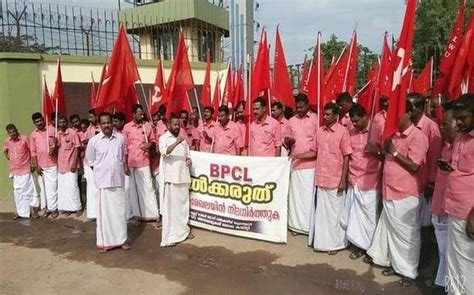by Com. K. N. Satyanarayana, General Secretary, HPCL Employees Union (CITU)

The world is facing another crisis because of Ukraine war. The formation of HPCL is also closely related to wars. During the 1972 war with Pakistan, private oil companies refused to cooperate with the Indian military even for refuelling. Then the Indian Government led by Indira, decided to nationalize the oil companies ESSO, BURMA Shell and Caltex. Accordingly, BPCL and HPCL were formed.
Nationalization of Caltex (CORIL, Caltex Oil Refinery India Ltd), situated at Visakhapatnam happened in 1976, while Standard Vacuum-ESSO was nationalized in Mumbai in 1974. By amalgamating these, the HPCL was formed in1978. A small gas distribution company, Kosana Gas, was also merged with HPCL in 1979.
Before this ONGC, GAIL and OIL were formed with a mandate of reducing crude oil imports.
By 1991 neo-liberal policies were started. However, due to inheritance of psyche of private management or MNC culture, the trade union activity is limited in the oil sector, where there is also less manpower and more automation, scattered across India. That is why disinvestment has happened without much resistance. HPCL is the first PSE to have been listed on the BSE (Bombay Stock Exchange) in1992. Nearly 49 % of HPCL’s share was off loaded by 1998. By now only around 53% shares of BPCL and around 57 % of IOC shares are with the Government.
By 2000, the threat of privatization loomed, in the name of opening up oil sector to private players. Then Reliance Petroleum, ESSAR Oil, came into the refining business, but they failed to penetrate into retail marketing. Some private LPG gas distribution companies also cropped up, but failed to deliver.
Around 2002, IBP was up for sale. Despite hurdles, it was taken over by the state owned oil major, IOC. During that period the threat of privatisation of BPCL and HPCL was stalled through some resistance like a three day historical strike in oil companies, and legal fight. These companies have been formed by way of an Act of Parliament. When our Officers’ Association approached the Supreme Court, it directed the Government to get the parliament’s approval for sale. The then minority Government lead by BJP withdrew its plan.
From then onwards, some trade union activity started in the oil sector.
After 2014, the privatization threat grew larger. But private players found it difficult to swallow these heavyweights. Then, to bring down oil imports the Government forced ONGC to take over HPCL, against its own mandate to ONGC of oil exploration and drilling.
By 2018, HPCL was sold to ONGC. Earlier ONGC was a cash rich company, without any debts. But then ONGC was also on weak finances. However it had the ability to borrow. In that way ONGC was forced to borrow from the market to buy HPCL, contrary to its mandated target of reducing oil imports. Now ONGC is finding it difficult to pump more funds into exploration and drilling and it is struggling due to Government policies which are against the PSUs.
Successive Governments are weakening PSU through various methods like shares buy back, more dividends, taking over other PSUs, investing in other PSUs, etc.
Now the BJP government has put up BPCL for sale. Due to various reasons the sale is getting delayed. It is under-valued through a faulty valuation method.
As oil PSUs are such big companies that private players are not in a position to swallow them, the Government has come up with a new, deceitful strategy in the name of the National Monetization Pipeline (NMP) policy, to sell public assets, including highways, parks, stadiums, railway stations, warehousing go-downs, cell towers, etc. The NMP is intended to sell our mammoth PSUs in small bite size bits to private players.
In the oil sector, the pipeline network, ETPs Sulphur Recovery Units, Hydrogen generation units which are more valuable and vital for our operations are being considered for long lease through the NMP. The pipeline network, built over decades with public money and sacrifice is also being leased out through the NMP. Earlier per km pipe line was valued at 10 crores of rupees, while now it is fixed at only 3 crores of rupees per km.
This NMP is a loot of public assets.
We all should oppose and fight against these plans.
The Petroleum Gas Workers Federation is fighting against BPCL privatization; as a part of that it conducted a Conference and took out a rally and held a public meeting at Kochi; another one is planned in Mumbai. The fact is that agitation is limited to some areas like Kerala.

Now we from the petroleum sector are aligning with the national movement against privatization. In the last ten to twelve years we have been becoming part of these struggles and have been taking part in All India strike calls. Here in Visakhapatnam, we are taking part in the anti-privatization agitation, built against the VSP (Vishakhapatnam Steel Plant) sale.
Earlier also the sale of the Dredging Corporation of India (DCI) was opposed by means of an agitation under the aegis of the Public Sector Coordination Committee. This agitation led to the takeover of DCI by a consortium of Public Ports, but not by private players.
Shipyard privatization was stalled and made to be merged with the Defence ministry. BHPV was taken over by BHEL.
We need to intensify our struggle further.
Undoubtedly, an Attack on One is an Attack on All!
